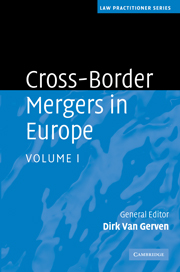Book contents
- Frontmatter
- Contents
- Contributors
- Preface
- Part I EC rules on cross-border mergers
- 1 Community rules applicable to cross-border mergers
- 2 Employee participation: rights and obligations
- 3 Tax rules applicable to cross-border mergers
- 4 Scope and limitations of the Cross-border Merger Directive
- Part II Application in each Member State National reports for the EU Member States
- Part III Application in the EEA Member States
- Part IV Annexes
- Index
4 - Scope and limitations of the Cross-border Merger Directive
from Part I - EC rules on cross-border mergers
Published online by Cambridge University Press: 03 May 2010
- Frontmatter
- Contents
- Contributors
- Preface
- Part I EC rules on cross-border mergers
- 1 Community rules applicable to cross-border mergers
- 2 Employee participation: rights and obligations
- 3 Tax rules applicable to cross-border mergers
- 4 Scope and limitations of the Cross-border Merger Directive
- Part II Application in each Member State National reports for the EU Member States
- Part III Application in the EEA Member States
- Part IV Annexes
- Index
Summary
1. Now that the Cross-border Merger Directive has been transposed in all Member States, it appears useful to examine the extent of its potential impact and its position in the context of cross-border mobility of companies in the European Union. Given the series of groundbreaking decisions of the Court of Justice of the EC (‘the European Court of Justice’ or ‘the Court’) on cross-border operations, such an examination must necessarily be carried out in the light of the fundamental freedoms enshrined in the EC Treaty, in particular the freedom of establishment. These decisions do not always produce the desired certainty. Consequently, this examination cannot yield more than a picture of the situation in October 2009.
2. Various questions arise. First, which cross-border operations are or are not feasible in the current state of development of Community law, apart from cross-border mergers under the Cross-border Directive? Second, which cross-border operations can companies achieve thanks to the Directive? Third, what are the limitations to which a cross-border merger under the Directive is subjected? These questions will briefly be examined in the next pages. First of all, however, I will make clear what I mean by ‘cross-border operations’ of companies, in particular in the context of freedom of establishment in the EU. Also, I will make a few introductory remarks on an issue that is vital to cross-border operations: the old controversy between two doctrines concerning the law applicable to companies, the incorporation doctrine and the real seat doctrine.
- Type
- Chapter
- Information
- Cross-Border Mergers in Europe , pp. 54 - 78Publisher: Cambridge University PressPrint publication year: 2010
- 6
- Cited by



